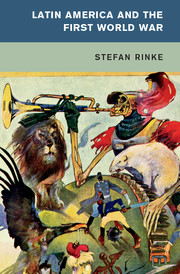Book contents
- Frontmatter
- Contents
- List of Figures
- Preface
- List of Abbreviations
- Introduction
- 1 The Global Context before 1914
- 2 Neutrality under Pressure, 1914-1917
- 3 In the Wake of War, 1917
- 4 Turbulent Paths into a “New Era,” 1918-1919
- 5 The Demise of a World
- 6 Nation and Trans-nation
- Epilogue: The Global Legacy of the World War
- Sources and Literature
- Chronology
- Index
4 - Turbulent Paths into a “New Era,” 1918-1919
Published online by Cambridge University Press: 09 March 2017
- Frontmatter
- Contents
- List of Figures
- Preface
- List of Abbreviations
- Introduction
- 1 The Global Context before 1914
- 2 Neutrality under Pressure, 1914-1917
- 3 In the Wake of War, 1917
- 4 Turbulent Paths into a “New Era,” 1918-1919
- 5 The Demise of a World
- 6 Nation and Trans-nation
- Epilogue: The Global Legacy of the World War
- Sources and Literature
- Chronology
- Index
Summary
The hope for a rapid end to the war, which some Latin Americans thought possible after the United States entered the conflict, dissipated by the end of 1917. The war was now a world war in every respect and no resolution was in sight. Latin America found itself increasingly more dependent on its demands. In many places, there were supply shortages. This gave way in 1918 to unrest that spread across the entire subcontinent. The revolt not only had domestic causes, for the threat posed by the revolutionary wave in Russia was increasingly felt in the region, too. The radicalization of social conflicts influenced the attitude toward the end of the war, which Latin Americans far and wide certainly welcomed enthusiastically. At the same time, the war's culmination in the Treaty of Versailles and the League of Nations also soon gave way to a sense of disillusionment.
THE “SUBTLE WAR” FOR REGIONAL HEGEMONY
“South America today is a vast battleground in which a subtle war is being fought for public opinion and commercial supremacy.” When the officials of the U.S. Creel Committee arrived at this conclusion in its activity report in mid-1918, they highlighted two dimensions that in fact remained critical for Latin America's involvement in the war. In the propaganda war, the Allies kept the upper hand in most countries of the region and drove out German activities. In the warring countries of Latin America, this propaganda was intended to stoke hatred of the Central Powers in order to divert attention from the hardships that the war brought with it or to make them more palatable. On the other hand, in those countries where governments had only severed relations or remained neutral in 1917, campaigns on behalf of entering the war persisted. Especially in the neutral countries, German propaganda continued to fight back intensively even in the last year of the war. The Allies were thus in no way able to realize their ambitious goal of motivating all of Latin America to enter the war.
The work of the Creel Committee was undoubtedly an asset for Allied propaganda in Latin America. Apart from the dissemination of its own material, which the committee boosted significantly in 1918, the monitoring and influencing of the Latin American media had top priority.
- Type
- Chapter
- Information
- Latin America and the First World War , pp. 161 - 194Publisher: Cambridge University PressPrint publication year: 2017



